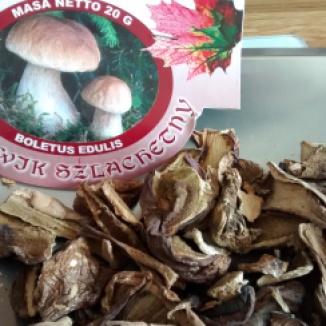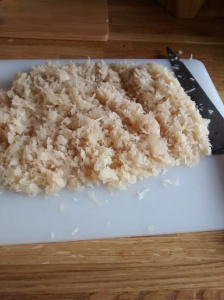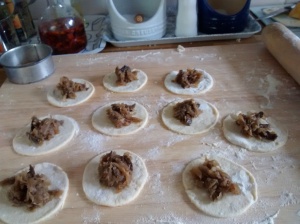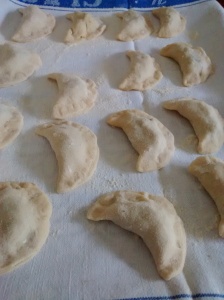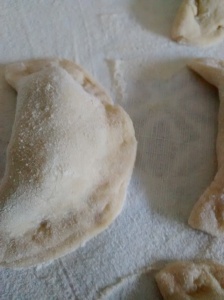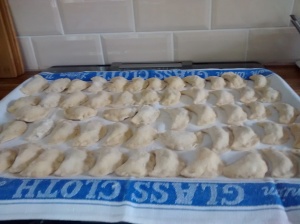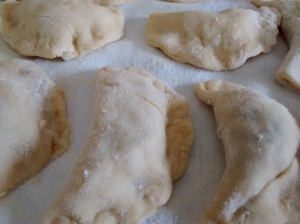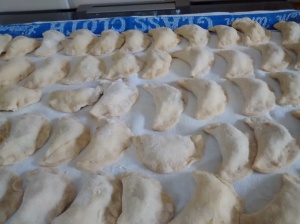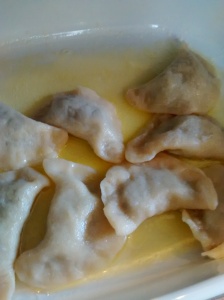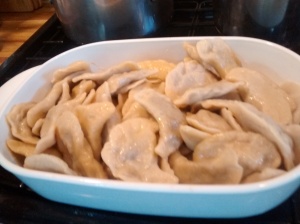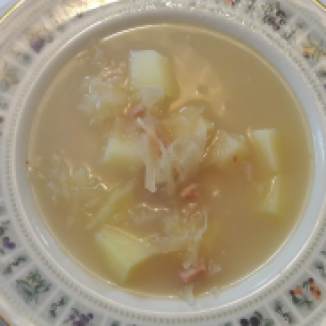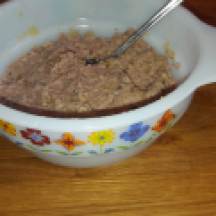- I tried some pierogi recently which had a variation on the sauerkraut filling.
- The mixture contained grated carrot.
- I discovered that the sauerkraut and carrot mix can be bought in a jar and this is what I used.
Ingredients – Filling
- 1 jar of sauerkraut and carrots
- 1 large onion – chopped fine
- 25 -30g dried mushrooms – soaked overnight
- Butter to fry the onion
- Salt & Pepper to taste
- OPTION
- Add fresh mushrooms fried in butter and chopped fine to the filling.
Method – Filling
- Soak the mushrooms overnight.
- Strain the mushrooms – keep the liquor.
- Chop the mushrooms into small pieces.
- Strain the sauerkraut and carrot mixture – keep the liquid – there may not be very much.
- Chop the sauerkraut and carrots into small pieces.
- Put the sauerkraut and carrot mixture and liquid into a pan.
- Add the chopped mushrooms and the liquor.
- Add boiling water to cover.
- Put a lid on the pan
- Cook the gently for around 30 minutes.
- Check occasionally.
- Leave to cool.
- Strain the mixture in a large sieve
- You can put this into a clean dry cotton or linen cloth and twist the ends together –
- Squeeze to get it really dry.
- *
- Chop the onions finely and fry them till they are soft and golden.
- Mix the sauerkraut, carrots, mushrooms and onions together.
- Add some ground black pepper to taste; salt should not be necessary.
- (Add the fried chopped mushrooms if using.)
- I have written much previously about pierogi – but have again included the instructions for the dough below.
Ingredients – Dough
- 500g pasta flour or strong flour or plain flour & 2 tablespoons of fine semolina
- 300ml water
- 1 tablespoon oil – sunflower or light olive
- ½ teaspoon salt
- 2 egg yolks
- *
- Melted butter to serve
Method
- In a jug or bowl mix together the water, oil and the yolks
- Put the flour and salt into a large bowl and make a well in the centre.
- Pour in the liquid from the jug and initially use a knife to mix this into the flour and then use your hands to mix the liquid and flour to get a ball of dough.
- Leave for around 20 -30 minutes in a cool place.
- Turn this out onto a floured board and knead the dough for a few minutes until you have a smooth ball.
- Cut the dough into quarters.
- On a floured board roll out a quarter at a time until you have a sheet of thinly rolled dough.
- Now prepare a large trays and cover them with clean tea towel sprinkle with flour.
- Place the sealed pierogi on this until they are all made, do not let then touch each other.
- I cut them out using a 7 cm diameter cutter.
- The excess dough can be re-mixed and rolled out again.
- Around a half tablespoon of filling is put on each circle and then they are folded over and the edges pinched together to make a good seal.
- You learn from experience how much filling to put in as too much will make it hard to seal them and if not properly sealed they will burst on boiling.
- Do not worry if you have a few mishaps – it still happens to me even with experience – it is hard to salvage one that has gone wrong – just accept that there will be a few that you do not cook.
- *
- To cook the pierogi, use a large pan of boiling water to which you have added some salt and a drizzle of oil.
- Drop the pierogi in one by one and allow them to boil. I usually do about 6 to 8 at a time (I only do 6 at a time if using frozen ones). ( I often open free some of them.)
- As they cook they will float to the surface, let them boil for 2 to 3 minutes, a bit more if they were frozen, and then remove them with a slotted spoon and put into a colander above a pan for a few seconds to drain.
- Continue boiling batches in the same water.
- If you want to make all the pierogi to serve together then you need to get a large shallow dish and put in the pierogi and add melted butter.
- As you take out the cooked pierogi add them in the dish.
- Keep the dish in a warm oven.
- Keep on adding more as they cook
- Do not let them stick together – keep mixing them in the butter.
- OPTIONS
- Serve with melted butter or
- Melted butter and breadcrumbs or
- Onions fried in butter or
- With fried bacon bits – skwarki.




